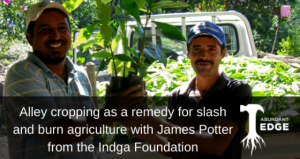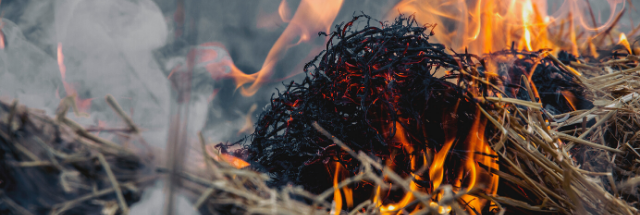Alley cropping as a remedy for slash and burn agriculture with James Potter from the Indga Foundation: 138
 "The first three interviews in this ongoing series on reforestation and agroforestry have highlighted small personal projects on private land, each with a different person in south or mesoamerica whose primary motivations are to restore the forests and biodiversity of their land. In all three cases producing a viable agricultural product was an important aspect of the project and one which brought in funds to keep the operation running, but profitable agriculture wasn’t the primary goal for any of them.
"The first three interviews in this ongoing series on reforestation and agroforestry have highlighted small personal projects on private land, each with a different person in south or mesoamerica whose primary motivations are to restore the forests and biodiversity of their land. In all three cases producing a viable agricultural product was an important aspect of the project and one which brought in funds to keep the operation running, but profitable agriculture wasn’t the primary goal for any of them.
In this interview I spoke with James Potter with the Inga foundation who talked with me about the work and project model of the foundation. In my own travels I’ve seen a lot of slash and burn agriculture all over the world from the rice paddies of the Philippines, the coffee plantations and corn fields of Guatemala to cattle ranching in Mexico and clearings for new palm oil plantations in Thailand and Malaysia. It used to baffle me that such a strategy for land management could still persist in this day and age. A lot of what I’ve tried to learn about in my time in those places centered around how people farmed and managed fertility on their parcels. In my talk with James he helps to explain the origins and motivations for slash and burn farming and the impact it has on the soil as well as the economics for the people who practice it.
From there we talk about the Inga Foundation’s unique approach to integrating inga trees and all of their beneficial properties into the farming strategy for people who are used to burning their land in between crop seasons. We also look into the pilot projects they’ve helped to create and the results of the implementation of this method over time. James also helps to unpack the common challenge of the transition period between the maturation of longer term perennial species where yields might be too low for subsistence farmers to sustain themselves. While I remain wary of any plan that promotes a standardized approach across many different contexts, I’ve been impressed by some of the fundamental challenges that this alley cropping solution presents for helping farmers transition into practices that take much better care of the soil and biodiversity of their land in the process.
This is an episode that I would love to hear opinions and feedback from any of you listening. Especially if you have personal experience working with alley cropping systems and intercropping within orchards or other tree plantations. Does the division work against the efficiency of the farm? Can the trees develop to a point where they shade out the crops in the alleys? How much diversity is beneficial for the trees and crops selected and at what point do they start to compete for resources like light and nutrients in the soil?"
Visit the website to listen to the podcast!
Originally posted:
Oliver M. Goshey on 15 November, 2019
https://www.abundantedge.com/abundantedge/james-potter?fbclid=IwAR3KFpUCJi59BoFjw_7cpIRO3B0JUJV24BR_gdVRaiZ7QO1Rrsep3kvfEfA



